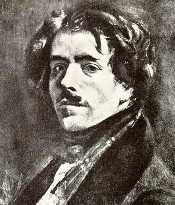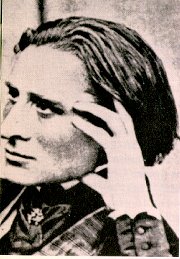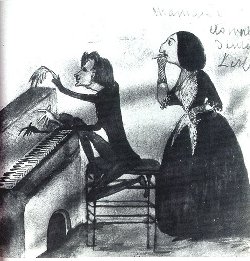
Frederic Chopin
(1810-1849)

The famous funeral march is actually a small part of a piece for piano. It is one theme from one movement of one sonata. The development of this theme ends furiously, with a low trill that suggests a struggle for air at the moments of death (perhaps coughing?). A second theme comes in, and can only be accurately called a lullaby. The effect is poetic and overtly romanticised, producing an aural metaphor for death as an "eternal sleep". The biographical connections to the artist that produced this music are as coincidental and strange as those connections between Mozart and his final requiem. The composer of this famous piece was none other than the great Dark Prince of the Piano, Frederic Francois Chopin.
In Vienna in 1827, pianist Franz Neopomuk Hummel visited the late Beethoven who was then on his deathbed. Hummel was, no doubt, indebted to the master for him being both a model and inspiration for his own music. A 17-year-old Chopin was then studying at Warsaw university, and becoming aware of Hummel's works. This teenager had already written music that made Beethoven's piano sound embarrassingly archaic, but noone yet knew of him outside of Poland. Two years later, the young Chopin would compose a Piano Concerto modelled closely on those of Hummel. But this is as close a connection that can be made between the polish-born Chopin and the towering German giant, Beethoven. Chopin's entire musical approach seemed to have glossed over Beethoven entirely, and had deeper roots in Mozart and Bach. Later, Chopin wrote about his dismissal of the the earlier master by referring to the "vulgar appeal" of his music.
There is no question that Chopin stands at the center of one of the greatest upheavels in the history of keyboard music. The introduction of the pedal during the "Beethoven generation" was physical proof that the way the instrument was being approached was in a phase of change, and by Chopin's generation, musical forms such as the sonata had become largely ignored. This abandoment of orthodoxy favoured ever-more ideosyncratic playing styles. Some writers admit that after hearing several measures of Chopin, you already know who you are listening to.
Chopin's piano playing has been (accurately) called all of these: lofty, aristocratic, highly refined, virtuosic. For me, no words can accurately describe the level of elloquence in his music. The compactness, effectiveness, and efficiency can be explained by the fact that the music was composed exactly with the piano and meant to be played on it. It harnesses the tonal and physical attributes of the instrument itself.
Some facts about Chopin's music:
1. 95% or more of his compositional output was for solo piano.
2. No recording artist has ever been able to record all of Chopin's daunting rhepetoire.
3. Chopin is no "backwater pianist" that the mainstream has never heard of. He is often compared to Mozart. Historians have claimed that his approach dominated Europe and Russia, and that it took the likes of Debussy and Prokoviev to make a true stylistic break.
Books can be written about his music, but let us move on to his life. This is not always proper for composers, but Chopin, in particular, has an intriuging and "juicy" biography.
The main facts on Chopin's Life:
1. He had turburceolosis his entire life, and he succumbed to it at the age of 39.
2. Chopin was born and grew up in a town outside of Warsaw, Poland, but speant most of his adult life in Paris, surrounded by an aristocratic elite.
3. His life was intimately intertwined with the French writer George Sand (Aurore Dupont), his cohorts in Paris included Franz Liszt, Berlioz, and Eugene Delacroix.
4. He hated performing in the concert hall.
5. 1839 was a great year for the master. It marks a year of prolific creative ouput and great social fame. Among the pieces composed then were the 24 Preludes, the scherzo in C-sharp minor, and the Funeral March. This should help clear up the mystery surrounding the address of this website.
An aside on the first name:
Depending on the source one may come upon, one finds numerous spellings for Chopin's first name. "Frederick" can be considered the American spelling, also found in German texts. "Frédéric" is the French spelling, and the one favoured above, minus the accent marks. "Fryderyk" (or "Fryderyka") is the Polish spelling. For the pedants, the way his name appeared on his birth certificate was most probably something very close to "Fryderyka Franciszek Chopin". I will give several reasons for using "Frederic Francois Chopin".
1. His father was French.
2. Chopin speant his adult life in, and died in, Paris.
3. Most of Chopin's works are dedicated to wealthy French women. Using the French spelling allows us to avoid mixing Polish, German, and French names all in one document.
4. I'm too lazy to add accent marks with my American computer.
The Delacroix Connection
Say you are a famous, wealthy Parisian painter. What do you do? Well, paint portraits of your buddies, of course!

![]()

The famous portrait of Chopin.
![]() A George Sand portrait.
A George Sand portrait.

A dashing self-portrait.
The Liszt Connection
Upon analyzing the music of Wagner, one might exclaim: "Wait! These Wagnerian harmonies were played by Chopin 20 years ago on the piano!" Upon reaching this conclusion, one would be correct. Intruigingly, no biography of Wagner contains a single mentioning of Chopin's name. Obviously there is something missing here. It turns out that the German uberpianist Franz Liszt is exactly the missing link that we need. In fact, his name appears multiple times in any given Wagner biography. We can invision Wagner getting Liszt alone, sometime late at night, and demanding that he show him what Chopin was doing on the piano. Wagner took notes.
One could write volumes about Liszt alone. He is considered by historians as the first internationally renown concert pianist. Today, amateur pianists can form endless, heated polemics about wether Liszt is a "better" pianist than Chopin. We have a very nice surviving daguerrotype of Liszt from 1841.
 Liszt, at the age of 30.
Liszt, at the age of 30.
How close were Liszt and Chopin? The answer is that there was not just a meeting between the two, but in fact, there existed a whole Chopin/Sand/Liszt nexus in Paris for many years. Several cartoons below demonstrate this very clearly. The first is a cartoon taken from a Hungarian newspaper poking fun at how routine it had become for us to see Liszt performing.

George Sand was actually a male pen name adopted by the novelist, Aurore Dupont. For one reason or another it stuck. She and Chopin never married, but in Paris they were treated like a married couple. She had custody of two children from previous marriages (plural) before meeting the master. One of her sons was Maurice, and he was an "artist" (of course). Below is a characiture Maurice had drawn quickly depicting his mother smoking and Liszt doing his usual.

In the 1830s, a "properly-mannered" woman did not wear pants or smoke in public. Sand did both. What follows here is a painting by Dannhauser. It speaks volumes.

Homosexuality?
As much as it pains me to do it, I could not help myself from leaving this section out. Admittedly, Chopin and Liszt were some of the greatest masters to have ever layed their hands on a piano. Historians often call the the 19th century the "Century of the Piano". Many hard-core music historians chide Chopin for never composing anything like a symphony or even a string quartet. Even during his lifetime, Chopin's own contemporaries occasionally chided him on this issue. We cannnot honestly begin to compare Chopin with the likes of Beethoven, simply because there were whole genres Beethoven mastered that Chopin utterly ignored. We are left with an image of a dandy that got by with his (solo) piano fireworks alone. One historian described Chopin as a sickly waif who wrote short piano works for teenaged girls to fawn over. I think this indictment is rough for one main reason, namely, that Chopin died before reaching his fourth decade. Contrast this with Liszt who lived a full life. He eventually retired as a pianist, and spent the latter half of his life writing "large scale" works, many of which are important and unique even today. Chopin just never had this chance.
While browsing the literature and biographies on these people, I came across an historian that described George Sand as "partly bi-sexual, almost exclusively homosexual." The mystery does not end with her. When Chopin attempted to marry a young Polish girl, her parents rejected the affair, citing Chopin's "unusual lifestyle". Some letters that Chopin is known to have sent to a MALE companion back home in Poland contain language that is suggestive. The historians marginalize the matter, explaining that "all men talked to each other like that back then."
The theories about what EXACTLY went on between these cultural figures range from the most conservative to the extreme and bizarre. The fact remains, that we will never know for sure. But I leave it as an exercise to the reader to examine the biographies and the "love letters" for yourself. Then decide for yourself what was really going on in the aristocratic atmosphere of a Paris in 1839.